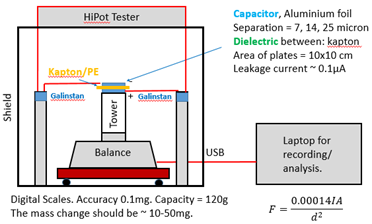For the past five months my Chief Engineer (Richard Arundal) and myself have been busy in the lab attempting to prove that one can extract propellant-less thrust from a capacitor by using quantised inertia. QI thrust is implied theoretically (McCulloch, 2013, 2017), but a capacitor approach was first suggested and tested by Becker and Bhatt (2018) who had read my paper on thrust and dielectrics (2017) and did some lab tests in liaison with me. Their work has been seconded by Mansell/IVO Ltd.
Curious to test this approach I used the last remaining DARPA money to set up a lab at Plymouth University, hiring Richard. What we now have in the lab is shown above, with a few details withheld for IP reasons. The capacitor (blue plates with orange dielectric) is placed on an insulating tower on a digital balance on a heavy damping plate. The capacitor is charged up to 5 kV with a HiPot tester (on top) via wires that pass their current through Galinstan, a cool liquid metal that breaks the physical connection to the outside world and allows the capacitor to ‘float free’ on the balance.
For the past month we have been struggling with an unwanted electrostatic
force, but we noticed an asymmetry as we flipped the capacitor. Recently I
have looked at all the data and used maths (including matrix algebra, that I always wanted to use for something useful!) to separate
out the EM force from the asymmetrical one. This extracted force is towards the
anode and looks like QI. It is about 10 milligrams, only 1/3 of the force
predicted (McCulloch, 2021) but there are good reasons why that might be, and
we will now look at those.
In short, unless we can think of another effect that could
cause a force towards the anode, then we have it and the transport & energy
industry will never be the same.
References
Becker, F.M. and A.S. Bhatt,
2018. Electrostatic accelerated electrons within symmetric capacitors during
field emission condition events exert bidirectional propellant-less thrust.
Arxiv: https://arxiv.org/abs/1810.04368
McCulloch, M.E., 2013. Inertia from
an asymmetric Casimir effect. EPL, 101, 59001. https://arxiv.org/abs/1302.2775
McCulloch, M.E., 2017. Testing
quantised inertia on emdrives with dielectrics. EPL, 118, 34003. https://iopscience.iop.org/article/10.1209/0295-5075/118/34003
